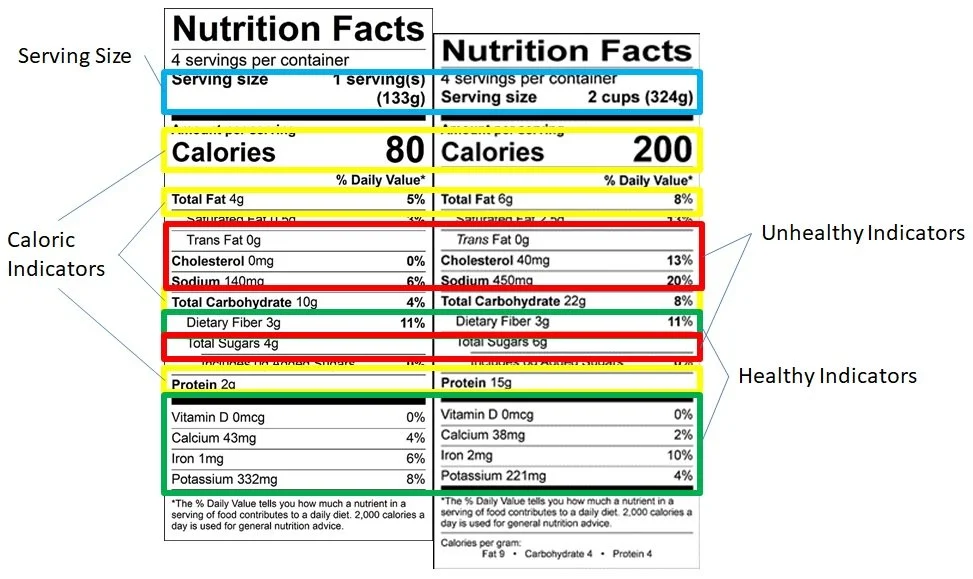How To Read A Food Label
Many people want to be healthier for themselves or their families. But good nutrition is often harder to obtain than a good workout routine. This is because food is a lot more than calories or nutrients. Food is what we serve our family, how we socialize with friends; it is part of religion and holidays. But despite all these complexities to nutrition it is important to understand what we are putting in your body, feeding your family, and friends.
Serving Size
The most important thing about serving size is to make sure that we are comparing apples to apples. Many companies will have different serving sizes on their various products to make them look healthier. Breakfast cereals are the first example I can think of where one company has multiple brands where a serving size is ½ cup, ¾ cup, 2/3 cup, or 1 cup.
If produce A has a ½ cup serving size (44g) that contains 50 calories and 7g of protein and product B has a 2/3 cup (59g) serving size that has 160 calories and 18g of protein. What is the better product if you want to limit calories and maximize protein? You cannot tell unless you do the math.
Caloric Indicators
These macronutrients provide our body with energy. Generally, people look at these to make sure that they are getting enough calories, protein, carbs, and fat. Everyone needs some balance of these nutrients. Even if you are restricting carbs, keto, Mediterranean diet, or if you want a balanced diet, you need to know how much protein, fat, and carbs your body is getting from each product.
Unhealthy Indicators
There are several nutrients that I consider unhealthy and that you want to minimize in your diet. Those are 1) trans fats, 2) added sugar, 3) cholesterol, and 4) sodium. Trans fat and added sugar should be minimized the most. Trans fats might be one of the most unhealthy “nutrients” in that it causes inflammation and can be linked negative health outcomes. The issue with added sugar is that many products have added sugar and if you are not careful it can be a lot of added sugar over the course of a day. Our bodies do not need added sugar and many products contain some natural sugar. Whereas we want to be mindful of cholesterol and sodium. Both sodium and cholesterol have important functions in our bodies. We do not want to eliminate these nutrients but we also want to be mindful that we do not overconsume.
Healthy Indicators
Health indicators include fiber as well as vitamins and minerals. I look at fiber to get a general sense of how much a product is healthy or plant-based. The more fiber a product has it is more likely to be less processed and more plant-based. In addition, only 5% of Americans get an adequate intake of fiber and there are health benefits of getting more. Generally, we need to increase our fiber consumption. The vitamin and mineral portion of the food label varies from product to product. All food labels must have vitamin D, calcium, iron, and potassium. Addition vitamins and minerals are generally listed when those vitamins and minerals are added to the product.
Ingredients List
The food ingredients list is a great place to look to see exactly what is in your food. But it can also be a bit mind-boggling and many people do not know where to start. The first thing to know when looking at an ingredients list is that the ingredients go from high to low, ingredients with the highest quantity are listed first and the ingredients with the lowest quantity are listed last. If something is not listed in the first 5-7 ingredients it generally is of a very small quantity.
If I do not like something from other indicators, too many unhealthy or too few healthy indicators, I do not look at the ingredients list because I have already ruled out the product. I look at the ingredients list second to verify the unhealthy parts of a food label. I do this because the FDA allows products to be listed as sugar-free or trans-fat-free when they contain .5g or less per serving.
If I see these on the ingredients list I put the product back:
Sugar: syrup, high fructose corn syrup, corn syrup,
Trans fat: partially hydrogenated oil and fully hydrogenated oil

